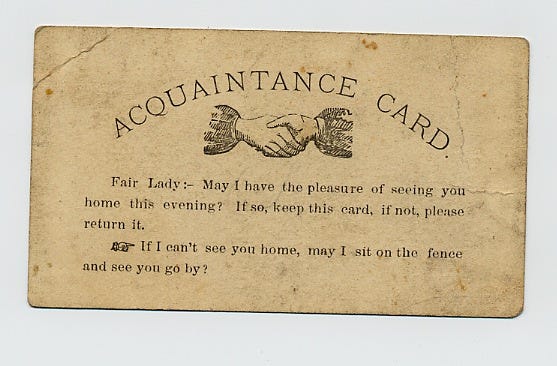Spoilers for a 2001 episode of This American Life follow, in order for me to make a nerdy point about narrative!
Even before the premiere of Serial, This American Life was putting out top quality long-form true crime journalism. When the twenty-year-old episode “House On Loon Lake” dropped in my feed last week, I remembered two things: I loved it, and I was sure it had a crime element. Perfect for this week’s newsletter!, I thought to myself. Well, I was right and I was wrong.
The episode, which is the only story covered (always a good sign), features Adam Beckman narrating his memories of exploring an abandoned house with his friends and family during summers in 1970s New Hampshire. The house is everything a mystery-loving kid could ask for: it’s empty, but not empty. The rooms are chock-full of items that are creepy in their abandonment (a party dress moldering in a closet, an ancient corsage pinned to a mirror), and just plain creepy (a doll with ITS FACE BURNED OFF). The basement seems to be blocked off to keep intruders out . . . or to keep someone or something in?
Listening to the opening minutes of the episode, I was trying to remember what had happened to the people who lived in the house: was it a family annihilator, a communal taboo broken, a mass murder?
The kids (and Beckman’s mom) who happened upon the house tried to figure out the same thing over the next few years. They act like characters in a mystery novel, or the hosts of a true crime podcast: gathering clues, interviewing townspeople about their memories, hoarding artifacts, and generating theories. Eventually, they come to discover the truth, which is both very surprising, and not that surprising at all: Nothing happened at the house; nothing out of the ordinary happened to the family. They were packrats, and the parents opened a store in a nearby town and moved into the apartment above, keeping the house for storage. Eventually the town burns the place down for liability reasons. Must happen all the time.
What interests me about the episode is how sure, and how excited, everyone was that they had discovered a new true crime text. However, what they actually were falling in love with to the point of obsession (at one point Adam describes himself as being thirteen years old with “a crush on a house”) was storytelling. They were seduced by the possibility of discovering, and creating, a true crime story, of murder or plague, or tragedy. And the power of this possibility was so enticing that I also misremembered the episode entirely, my mind papering over the reality of the conclusion’s mundanity with a story just as captivating and lurid as the one Beckman and his friends were sure they were uncovering.
In a recent issue of The New Yorker, the brilliant and provocative Parul Sehgal describes what she calls “The Tyranny of the Tale” (I’ll link in case anyone can scale the paywall). In her essay, she argues that the paradigm of storytelling has proliferated well beyond the bounds of books or films, and has influenced everything from advertising to economics to political appointments. And she’s not sure this is good news. As she writes:
Story lulls. It encourages us to overlook the fact that it is, first, an act of selection. Details are amplified or muted. Apparent irrelevancies are integrated or pruned. Each decision is an argument, each argument an imposition of meaning, each imposition an exercise of power. When applied to history, it is a process that the late scholar Hayden White termed “emplotment”—in which experience is altered when squeezed into even the most rudimentary beginning-middle-end structure.
Basically, Sehgal wonders, “What is it that story does not allow us to see?”
It’s a fascinating and game changing question, particularly for true crime. The impulse to narrativize violence, to make sense of the senseless, is laudatory, I think, when its aim is to expose and interrupt the social structures and institutions that promote and condone exploitation of and harm against vulnerable people. However, to repeat, what about crime does story not allow us to see? When we shape indescribably awful things into narrative descriptions, we must be losing something. What is it?
This question is explored from a different angle in the latest podcast from Serial Productions: The Retrievals. The excellent five-part series focuses on a group of women who underwent egg retrieval procedures without the anesthetic fentanyl because a nurse was stealing the drug to support a crippling addiction. The pain the women felt was repeatedly and consistently dismissed as either their own failing (they were scolded for asking for “more” medicine or told they were “too sensitive”), or a mystery their medical team was not motivated to solve. In response to this betrayal, the women, as creator Susan Burton explains, created stories to soothe themselves:
The story becomes a way not only to explain pain, but to cope with it, a way to not only make sense of the pain, but to manage it, to tamp it down, get through it. In this way, the story becomes the medicine that the patients weren't given.
In this case, stories became a way for the women to create for themselves an explanation for their traumatic experience before they knew that the real reason for their suffering was criminal negligence. Though The Retrievals does describe a crime and its aftermath—the theft of the fentanyl and the trial of the nurse responsible—it also has a connection to “House on Loon Lake” through its treatment of a story that is not a crime, but is criminal both in its cruelty and its devastating impact on lives and communities: the way medical institutions routinely downplay and disregard women’s pain.1
The subtitle of Elinor Cleghorn’s historical analysis of the way patriarchal and sexist medical practices impact women’s health, Misdiagnosis and Myth in a Man-Made World, explains and supports its title: Unwell Women. She maintains that male dominance was “cemented into medicine’s very foundations,” and medicine operates as a “system of power” that perpetuates and upholds patriarchy. As medical practices evolved, a medico-scientific system emerged that both normalized and mystified the patriarchal imperative to control, discipline, and surveil women’s bodies. This impulse is even more insidious and damaging when women of color interact with medical professionals.2 I believe that true crime is a place where this grey area between neglect, oversight, and criminal malpractice can be explored, expanded, and documented.
In a harrowing but essential memoir exploring her diagnosis of and treatment for an aggressive form of breast cancer in her early 40s, poet Anne Boyer relentlessly interrogates the clichés and euphemisms that circulate around women’s illnesses, providing yet another perspective on how story intersects with pain. Pushing back against the notion most concisely articulated by Elaine Scarry, that pain “destroys language,” Boyer instead argues that “pain doesn’t destroy language: it changes it.” She insists that believing pain is somehow inexpressible or illegible outside of the suffering person is evidence of a social imperative to ignore the pain of others:
So the question, finally, is not whether pain has a voice or appearance: the question is whether those people who insist that it does not are interested in what pain has to say, and whose bodies are doing the talking.
“The Retrievals” is expressly and intimately interested in excavating and articulating the pain of the women who were hurt not only by one person’s criminal actions, but also due to the failure of an institution to recognize, or to listen to, their bodies in pain. This true crime story might not be exhaustive —several of the women resist narrativizing the most intimate elements of their experiences—but it does insist upon the importance of documenting what happened to them in the way they choose to speak about it.
Perhaps this is one way to if not answer, then at least address, the question of what is left out when we make stories out of suffering. Maybe it’s impossible for one story to avoid altering, revising, and framing the raw material of life, but by including, amplifying, and mingling many such (necessarily) incomplete narratives, we can produce and preserve an authentic account of crime that is true in a way that matters.
Though Donna, the nurse who admitted to and was convicted of stealing the fentanyl and replacing it with saline, refused to be interviewed, Burton does attempt to contextualize her devastating choices by describing her hardships as a single mother dealing with an abusive ex.
Cleghorn’s book addresses this disparity, as have literally hundreds of studies, evidenced by the 9 million-plus results my google search for “disparities in healthcare for women of color” produced.





